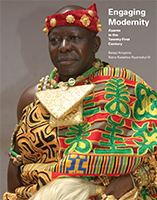
Engaging Modernity: Asante in the Twenty-First Century
Skip other details (including permanent urls, DOI, citation information): This work is licensed under a Creative Commons Attribution-NonCommercial-NoDerivatives 3.0 License. Please contact [email protected] to use this work in a way not covered by the license.
For more information, read Michigan Publishing's access and usage policy.
Kɔkroanya
Nana Akwasi Boadi Amponim
Kɔkroanyahene
Kɔkroanya etymologically is a compound word and comes from kɔkwan a ɛnya (literally, does not travel without). The Asantehene rarely leaves it behind on his official duties during state ceremonies, when he attends funerals, or on his travels in Ghana and abroad. Members of the kɔkroanya group came to Kumase from Denkyira Jokwaa during Asantehene Opoku Ware’s time. The history is told of one Nana Gyakari, head of the family at the time, who realized that the only female member of his lineage, Akosua Darkwaa, could not bear children and that would have potential consequences for the future of the matrilineage. Nana Gyakari was advised to go to Kumase where it would be likely that they would find the solution to his sister’s barrenness. He traveled to Kumase with his sister and a maidservant. After meeting with King Opoku Ware, the Asantehene asked his uncle, the Nsutahene, to give them a place to live. Nsutahene gave them a piece of land at Nsuta Amoaman, however, his decision to marry Akosua Darkwaa created a misunderstanding between him and Nana Gyakari which led to the beheading of their maidservant. When Nana Gyakari informed Opoku Ware, he summoned his uncle, but it was too late, the harm had been done. Opoku Ware decided to create kɔkroanya trumpets for them to use as part of the regalia of the Gold Stool. So the kɔkroanya group precedes the Gold Stool in processions or the Asanthene’s stool in the absence of the Gold Stool. Since they were royals (adehyeɛ) at Jokwaa, they could always go to him directly without going through an intermediary. They do not have to lower their cloth when they are in his presence and performing their duties. Akosua Darkwaa later had three children, Ɔbasɛm, Manu, and Mansa. Descendants of these three siblings are the rightful heirs to the kɔkroanya stool and they do so on a rotational basis. Nana Gyakari was the first chief while the present chief of Kɔkroanya, Nana Akwasi Boadi Amponim, is a descendant of Mansa. Kɔkroanya’s repertoire is similar to ntahera. Due to the disruption that happened when Asantehene Prempeh was in exile for twenty-nine years, the kɔkroanya fell into disuse until Asantehene Agyeman Prempeh I revived it by having the ntahera group teach kɔkroanya their repertoire. In the 1950s the ntahera also had some challenges and it was members of the kɔkroanya group who taught ntahera members the repertoire.




